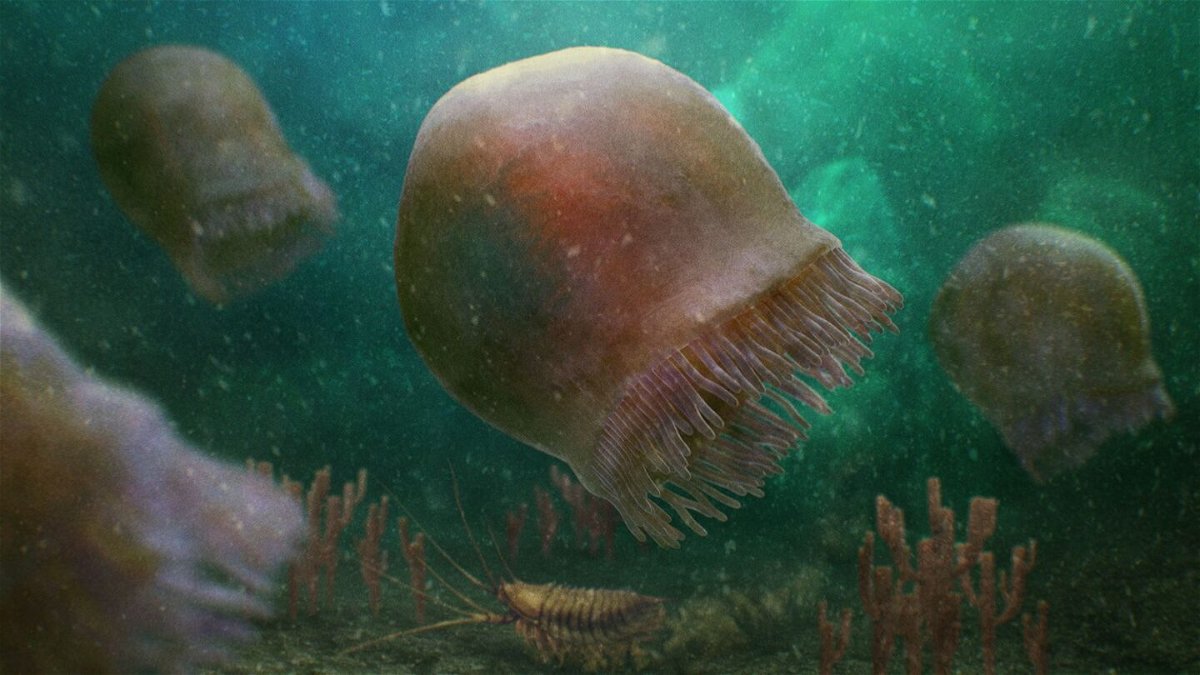Oldest known species of jellyfish discovered in the Canadian Rockies

The Burgess Shale's Raymond Quarry
By Ashley Strickland, CNN
(CNN) — The oldest examples of swimming jellyfish, which lived in Earth’s oceans 505 million years ago, have been discovered high within the Canadian Rockies. Researchers found 182 fossils encased within the rock of the famed Burgess Shale fossil site.
The fossils belong to a previously unknown species of jellyfish, called Burgessomedusa phasmiformis, that shows just how evolved these creatures already were millions of years ago.
The exceptionally well-preserved fossils are a remarkable find, given that the soft-bodied animals are made of 95% water. The jellyfish measure about 8 inches (20 centimeters) in length.
A study detailing the findings was published Tuesday in the journal Proceedings of the Royal Society B.
Jellyfish are medusozoans, or animals with an umbrella-shaped body and stinging tentacles, like the mythical snake-haired Medusa. Medusozoans, corals and sea anemones fall under a larger group called Cnidaria, one of the oldest groups of animals to exist on the planet.
Cnidarians can have different body forms within their life cycle, including a polyp, which is shaped like a vase and usually attached to something like the seafloor.
Medusozoans take their name from a form called the medusa, which is a bell or saucer-shaped body. Medusozoans begin as polyps and are capable of taking form as medusas within their life cycle, some of which have the ability to freely swim. Medusozoans include modern box jellies, hydroids, stalked jellyfish and true jellyfish.
The multitude of Burgessomedusa phasmiformis fossils at the site showed that large, swimming bell-shaped jellyfish evolved more than 500 million years ago.
“Although jellyfish and their relatives are thought to be one of the earliest animal groups to have evolved, they have been remarkably hard to pin down in the Cambrian fossil record. This discovery leaves no doubt they were swimming about at that time,” said study coauthor Joe Moysiuk, a doctoral candidate in ecology and evolutionary biology at the University of Toronto, in a statement. He is based at the Royal Ontario Museum.
Treasure trove of rare fossils
While fossilized polyps have been found dating back 560 million years, it has been more difficult for researchers to trace the origins of free-swimming jellyfish.
Many of the fossils were initially collected at the Burgess Shale in the 1980s and 1990s during excavations conducted under Desmond Collins, former Royal Ontario Museum curator of invertebrate paleontology.
But it has taken time to sort through and study all of the individual specimens.
The Burgess Shale was first discovered in 1909 by Charles D. Walcott, secretary of the Smithsonian Institution in Washington, DC. The 508 million-year-old site is a gold mine of well-preserved fossils, including those of soft-bodied animals. In addition to preserving bone, the site includes incredibly detailed imprints and outlines of the soft tissue and internal anatomy of more delicate sea creatures, which is rare in the fossil record.
The site is so well-preserved because an underwater avalanche of fine silt and mud quickly trapped a large group of animals, showcasing the diversity of life living in Earth’s oceans at the time. Those specimens include now-extinct creatures that have no relation to any current life-forms on Earth. The animals essentially became laminated between layers of mud that fossilized over time.
Soft-bodied predators
The intricate Burgessomedusa phasmiformis fossils are now on display at the Royal Ontario Museum, as part of its Burgess Shale collection.
The more that researchers study fossils from the Burgess Shale, the more complex the ancient food chain becomes. At first, scientists thought large swimming arthropods, like the Anomalocaris seen in one of the same rock fossils preserving Burgessomedusa, were the main predators.
But Burgessomedusa, with its 90 finger-like tentacles that could grab prey, may have been a formidable marine predator as well.
“Finding such incredibly delicate animals preserved in rock layers on top of these mountains is such a (wondrous) discovery. Burgessomedusa adds to the complexity of Cambrian foodwebs, and like Anomalocaris which lived in the same environment, these jellyfish were efficient swimming predators,” said study coauthor Dr. Jean-Bernard Caron, the Royal Ontario Museum’s Richard Ivey Curator of Invertebrate Palaeontology, in a statement. “This adds yet another remarkable lineage of animals that the Burgess Shale has preserved chronicling the evolution of life on Earth.”
The-CNN-Wire
™ & © 2023 Cable News Network, Inc., a Warner Bros. Discovery Company. All rights reserved.